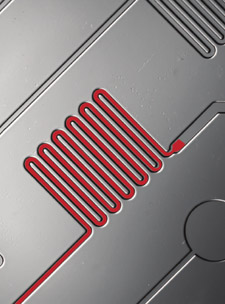The Right Tool for the Job
By Leslie Mertz
NOTE: This is an abstract of the entire article, which appeared in the November/December 2011 issue of the IEEE Pulse magazine.
Click here to read the entire article.
In the biological world, where the typical human cell is less than 10 µm in diameter, an average bacterium a few micrometers long, and the garden-variety virus about 100 nm in length, more and more researchers view microscopic tools known as biological microelectromechanical systems (bioMEMS) as the right choice for keeping patients alive and healthy. BioMEMS are an outgrowth of MEMS – the sensors, actuators, and other microchips – developed for the electronics industry. MEMS are present in everything from computers and ink-jet printers to automobile air bags and digital video projection systems.
BioMEMS are MEMS directed mainly toward biomedical uses. Today, for instance, a person goes to a medical laboratory to have blood drawn, and in a week or two, gets the results from the doctor. The costs for such tests can run into hundreds. On the other hand, with new bioMEMS technology that is on the horizon, the same person could prick a finger, deposit a drop of blood on a small testing cartridge, and read the results in a few minutes – all without ever leaving home. Not only would this eliminate a trip to the laboratory, but it would also greatly decrease the amount of blood needed for testing. In addition, it would reduce the amount of reagents required to perform the blood test, and this would help to lower costs.
BioMEMS are already doing or have the potential to do many medical tasks faster, better, and cheaper than traditional methods. A few examples are:
- quick scanning for and diagnosis of a profusion of diseases from a single drop of blood
- generation of artificial tissues that can help a patient’s damaged organ to function again
- testing of drugs without animal experimentation
- identification of the earliest signs that cancer is spreading, allowing doctors to provide more effective treatment
- highly accurate, yet inexpensive, easy-to-use, and easy-to-interpret patient diagnostics in Third World nations, where hospitals are few and far between.
In the article, the author reports on three major areas of application where bioMEMS promise to transform medical care: Diagnostics and Therapeutics, Tissue Engineering for Transplantation, and Drug Testing. In each area, key participants in the field express their views on the prospects of bioMEMS.
Diagnostics and Therapeutics
Diagnostics and Therapeutics One of the hottest areas for bioMEMS is diagnostics: taking a small sample of blood or other bodily fluid from a patient and testing it for various diseases right at the bedside, rather than sending it out to a laboratory and waiting a day or more for the results.
A key factor in this area is the improved understanding of microfluidics, or how extremely small volumes of fluid behave, is vital to those advancements. This is because bioMEMS usually require that blood or other bodily fluids move through miniscule channels built onto a tiny electronic chip so that sensors can read the fluid’s components.
The article describes how bioMEMS could be used in detecting/counting microscopic components (e.g., blood cells, bacteria, tumor cells, and cancer markers) that are found in fluids. In all these areas the bioMEMS offer increased speed and convenience of analysis, along with decreased testing cost.
A microchip, called the mChip, has been used experimentally in the third world to detect both HIV and syphilis. The device exposes a drop of blood to a series of reagents and produces easy-to-read results in a matter of minutes. The research group involved tested the chip in Rwanda, where the rates of HIV infection and syphilis are very high, and found that it could correctly identify the two conditions almost 99% of the time.

When added to the mChip, a drop of blood moves through miniscule channels where it is exposed to a series of reagents. This produces easy-to-read results in few minutes. (Photo courtesy of Samuel Sia.)
Tissue Engineering for Transplantation
While Tissue Engineering is currently being undertaken without the use of bioMEMS, growing complex tissues demand a network of capillaries. According to Ali Khademhosseini, Ph.D., associate professor at Harvard Medical School. “This is where bioMEMS starts playing a role.” He explained that tissue engineering may be an answer to a particularly vexing health problem: the lack of available organs for transplantation.
Drug Testing
Currently, scientists develop a drug candidate, spend many, many weeks testing it on animals, and if all goes well, proceed to human testing, which can take many, many months. Negative findings along the way can send the scientists back to the drawing board. However, with artificial tissues, scientists can test a large number of drug candidates simultaneously and without the costly and sometimes inconclusive animal testing. Khademhosseini’s research group hopes to put the engineered tissues and cells on biochips for use in drug testing.
Further Applications
Other current or forthcoming bioMEMS applications include electrode arrays that act as artificial retinas for use in patients with macular degeneration and retinitis pigmentosa; new and improved instruments for image-guided surgery; easy-to-swallow imaging devices (endoscopes) that reveal internal organs and body cavities without patient discomfort; DNA microarrays to study gene activity and to detect genes and mutations; and sensors for environmental testing, including the rapid detection of pathogens. The possibilities are seemingly endless.
ABOUT THE AUTHOR
Leslie Mertz (LMERTZ@nasw.org) is a freelance science and medical writer and an author as well as an educator.






